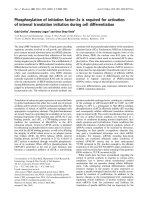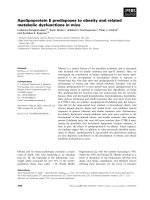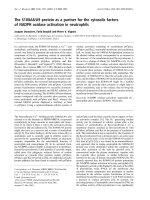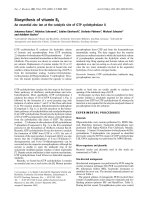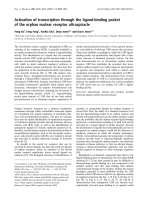Báo cáo y học: ""Getting your message through": an editorial guide for meeting publication standards" pdf
Bạn đang xem bản rút gọn của tài liệu. Xem và tải ngay bản đầy đủ của tài liệu tại đây (181.7 KB, 4 trang )
BioMed Central
Page 1 of 4
(page number not for citation purposes)
Scandinavian Journal of Trauma,
Resuscitation and Emergency Medicine
Open Access
Editorial
"Getting your message through": an editorial guide for meeting
publication standards
Kjetil G Ringdal*
1,2,3
, Hans Morten Lossius
1,4
and Kjetil Søreide
4,5
Address:
1
Department of Research, Norwegian Air Ambulance Foundation, Drøbak, Norway,
2
Division of Emergency Medicine, Oslo University
Hospital Ullevål, Oslo, Norway,
3
Faculty of Medicine, Faculty Division Ullevål University Hospital, University of Oslo, Oslo, Norway,
4
Department of Surgical Sciences, University of Bergen, Bergen, Norway and
5
Department of Surgery, Stavanger University Hospital, Stavanger,
Norway
Email: Kjetil G Ringdal* - ; Hans Morten Lossius - ; Kjetil Søreide -
* Corresponding author
Getting your message through
"Getting your message through" is the sine qua non of
medical science. If you cannot make your peers under-
stand your message, then you are bound to have manu-
scripts rejected or to have difficulties getting your valuable
research published, read, and perused. The challenge for
the scientist clinician is to present readable papers of gen-
eral interest for judgment by editors, editorial board
members, and peer reviewers while soundly describing
the methods in a way that is recognizable to any knowl-
edgeable scientist. Furthermore, the editors and governors
of any Journal have the responsibility to ensure that the
contributors' work receives the highest possible visibility
by ensuring proper indexing and tracking.
The Scandinavian Journal of Trauma, Resuscitation and
Emergency Medicine (SJTREM) is a peer-reviewed interna-
tional journal indexed in PubMed, PubMed Central, Sco-
pus, and Google Scholar. In addition, SJTREM has
recently been accepted for indexing by MEDLINE. Deci-
sions on tracking in EMBASE and by Thomson Reuters
will occur shortly. The Journal is directed towards all
health professionals involved in pre- and in-hospital
emergency medicine and surgery, critical care, and trauma
management. While SJTREM was primarily intended for a
Scandinavian and Northern-European audience [1], it has
received international attention and the journal deliber-
ately works to increase its international attention [2]. The
Journal follows the standards put forward in the 'Uniform
Requirements for Manuscripts Submitted to Biomedical
Journals' from the International Committee of Medical
Journal Editors (ICMJE) [3], and is a member of the Com-
mittee on Publication Ethics (COPE) [4]. The editors have
established and will continue to establish agreements
with international clinical experts and researchers to pro-
vide subject-specific reviews.
The strength of evidence
High quality scientific papers begin with a sound research
design [5-7]. In addition to presenting the data and pro-
viding analysis of the results, the data must be subjected
to statistical analysis using precise and correct methods [8-
10].
Studies in trauma, resuscitation, and emergency medicine
typically deal with interventions, but studies on preven-
tion and aetiology, diagnosis and prognosis, and eco-
nomic considerations are also relevant. For interventional
trials, four attributes define the strength of a study's evi-
dence. First, the level of evidence is attributed to the type of
study design used (Tables 1 and 2) [11]. Second, the qual-
ity of the evidence is assessed by the presence or lack of bias
Published: 23 December 2009
Scandinavian Journal of Trauma, Resuscitation and Emergency Medicine 2009, 17:66 doi:10.1186/1757-7241-
17-66
Received: 17 December 2009
Accepted: 23 December 2009
This article is available from: />© 2009 Ringdal et al; licensee BioMed Central Ltd.
This is an Open Access article distributed under the terms of the Creative Commons Attribution License ( />),
which permits unrestricted use, distribution, and reproduction in any medium, provided the original work is properly cited.
Scandinavian Journal of Trauma, Resuscitation and Emergency Medicine 2009, 17:66 />Page 2 of 4
(page number not for citation purposes)
(Table 3) [5]. The third attribute is statistical precision,
which is the ability of an analysis to distinguish true
effects from effects merely resulting from random chance.
Fourth, the choice of the study endpoint used to measure
the effect depends on both the clinical value of that end-
point and the magnitude of the observed effect. As a given
study may have strengths and weaknesses among these
parameters, we will address some basic requirements that
we look for in any study submitted to the Journal.
Requirements for describing the study design
The most important phase of any research project is the
planning and study design phase. Errors and shortcom-
ings in this phase can have major negative impacts on the
validity and reliability of the results. Incomplete and
unsatisfactory reporting of research impedes the assess-
ment of the strengths and weaknesses of studies reported
in international scientific journals. The SJTREM requires a
reader-friendly presentation of specific objectives, includ-
ing any prespecified hypotheses, as well as information on
the study's population, eligibility criteria for participants,
and the setting and locations where the data was collected.
Additionally, the frequency and cause of missing data
should be reported along with a description of how miss-
ing data was handled.
The authors are required to present the statistical methods
and tests used. In order to increase the reporting stand-
ards, SJTREM supports the use of the widely adopted Van-
couver guidelines, which require authors to "describe
statistical methods with enough detail to enable a knowledgea-
ble reader with access to the original data to verify the reported
results" [8]. For instructions on how to report statistical
results in research manuscripts, we recommend using
some of the more comprehensive books on the topic
[7,12,13].
Suggested guidelines for reporting biomedical
research
The Editors of the SJTREM recommend that authors fol-
low specific guidelines for reporting biomedical research
studies available at the EQUATOR Network website [14].
Table 1: The Oxford Centre for Evidence-based Medicine Levels of Evidence.
Level Therapy Diagnosis
1a Systematic review (SR) of Randomised Clinical Trials (RCT) SR of Level 1 diagnostic studies;
Clinical Decision Rule (CDR) with 1b studies from different
clinical centres.
1b Individual RCT (with narrow confidence interval) Validating cohort study with good reference standards, or CDR
tested within one clinical centre.
1c All or none
††
Diagnostic finding whose specificity is so high that a positive
result rules-in the diagnosis.
Diagnostic finding whose Sensitivity is so high that a Negative
result rules-out the diagnosis.
2a SR of cohort studies SR of Level 2a-c diagnostic studies
2b Individual cohort study
(including low-quality RCT; e.g., follow-up of <80% of patients)
Exploratory cohort study with good reference standards;
CDR after derivation, or validated only on split-sample or
databases
2c Audits or "outcomes" research; Ecological studies
3a SR of case-control studies SR of Level 3b and better studies
3b Individual Case-Control Study Non-consecutive study; or one without consistently applied
reference standards
4 Case-series (and poor-quality cohort and case-control studies) Case-control study, poor or nonindependent reference
standard
5 Expert opinion without explicit critical appraisal, or based on
physiology, bench research or 'first principles'
Note: †† Met when all patients died before the Rx became available, but some now survive on it; or when some patients died before the Rx became
available, but none now die on it.
The table is adapted and published with permission from the Oxford Centre for Evidence-based Medicine [11].
Table 2: Grades of Recommendation.
Grades Study design
A Consistent level 1 studies
B Consistent level 2 or 3 studies or extrapolations from level 1 studies
C Level 4 studies or extrapolations from level 2 or 3 studies
D Level 5 evidence or troublingly inconsistent or inconclusive studies of any level
The table is published with permission from the Oxford Centre for Evidence-based Medicine [11].
Scandinavian Journal of Trauma, Resuscitation and Emergency Medicine 2009, 17:66 />Page 3 of 4
(page number not for citation purposes)
In particular, commonly available guidelines and check-
lists should be followed when reporting randomized con-
trolled trials (CONSORT statement) [15], systematic
reviews (PRISMA statement) [16,17], diagnostic accuracy
studies (STARD statement) [18], and observational
research (STROBE statement) [19]. Articles concerned
with improvement in healthcare quality can follow the
SQUIRE guidelines [20,21]. Meta-analyses of randomized
trials must adhere to the guidelines outlined in the
PRISMA statement, while meta-analyses of observational
research must adhere to the MOOSE statement guidelines
[22,23]. The intentions of these statements are to identify
the aspects of various research designs that must be
reported to permit an adequate evaluation of the research
[12].
Where should the information be presented?
Readers and editors of a paper need to know what was
planned (and what was not), what was done, what was
found, and what the results mean. Hence, we suggest
structuring the text of original research articles into head-
ings summarised by the mnemonic acronym IMRAD
(Introduction, Methods, Results, And Discussion)
[8,13,24]. This basic structure is common to standard sci-
entific papers, although there may be minor variations.
The introduction or background section should be brief,
but to the point, and should tell readers why the study was
undertaken [13]. A straightforward way to structure the
introduction would be to separate it into three parts: first,
describe what is known and/or what the accepted status of
the current topic is; second, describe what is unknown
and what should be examined more closely; and finally,
describe the aim(s) and purpose(s) of the study [25].
The methods section answers the questions "who, what,
why, when, and where?" This section should include
information regarding how the study was planned and
designed, the included patient population, and how the
sample was selected/recruited. Additionally, the means
used to gather information must be presented along with
the statistical methods and the statistical package used for
analysis.
In the results section, authors should report the actual
study sample (number of study subjects that were eventu-
ally included or participated). If necessary, this informa-
tion can be presented in a flow chart. Additionally,
authors should describe the outcomes and results,
addressing one topic per paragraph, and working from the
most important topic to the least important topic.
Remember that the results should be presented objec-
tively, without any qualitative words, evaluations, or
interpretations; these statements belong in the discussion
section. Tables and illustrations are meant as a supple-
ment to the text, and the fewest possible number of tables
and illustrations should be used. Data in tables and fig-
ures should be presented in the manner that results in the
most clarity. One point worth stressing is that authors
should avoid including tables with large amounts of data,
as readers may find these too busy and difficult to read. All
tables and figures should be comprehensible without
referring to the text, and should have titles that are suc-
cinct and sufficiently self-explanatory [24].
The discussion section should begin with a clear and
unambiguous summary of the key findings in no more
than two or three sentences. Next, it must include a discus-
sion of the strengths and weaknesses of the study. This
should be followed by a comparison of the results with
those from other published work. Only the major relevant
works that confirm and contradict the findings should be
cited. Next, this section should discuss what the study
might indicate, explain the findings, and describe whether
and how the study has increased the understanding of the
field. Finally, authors should discuss what questions
remain unanswered and suggest future work in the area
[13,25,26].
The SJTREM strives to publish articles that are timely,
credible, and enjoyable to read. We aim to publish origi-
nal, important, and well-documented peer-reviewed
research articles. The Editors expect authors to follow
good standards and ethics for publication, and will take
action regarding any report or detection of fraudulent
research or scientific misconduct. We encourage authors
to use SJTREM as a publication venue for reviews and orig-
inal research papers in pre- and in-hospital emergency
medicine and surgery, critical care, and trauma manage-
ment, and we encourage authors to follow these guide-
lines for study design and presentation to ensure high
quality scientific communication.
Table 3: Major types of study bias in clinical research.
Bias Source of error
Selection bias Sample distorted by selection process
Information bias Misclassification of the variables
Confounding bias An extraneous variable that accounts for the observed result rather than the risk factor of interest
Publish with BioMed Central and every
scientist can read your work free of charge
"BioMed Central will be the most significant development for
disseminating the results of biomedical research in our lifetime."
Sir Paul Nurse, Cancer Research UK
Your research papers will be:
available free of charge to the entire biomedical community
peer reviewed and published immediately upon acceptance
cited in PubMed and archived on PubMed Central
yours — you keep the copyright
Submit your manuscript here:
/>BioMedcentral
Scandinavian Journal of Trauma, Resuscitation and Emergency Medicine 2009, 17:66 />Page 4 of 4
(page number not for citation purposes)
References
1. Lossius HM: The Scandinavian journal of trauma, resuscita-
tion and emergency medicine - grown up at last. Scand J
Trauma Resusc Emerg Med 2008, 16:1.
2. Soreide K, Lossius HM: A year of contemplation: looking back
and moving forward. Scand J Trauma Resusc Emerg Med 2009,
17:31.
3. ICMJE: International Committee of Medical Journal Editors.
[ />]. Accessed: November 24, 2009
4. COPE: Committee on Publication Ethics. [http://publicatione
thics.org/]. Accessed: November 24, 2009
5. Rothman KJ, Greenland S, Lash TL: Modern Epidemiology Third edition.
Philadelphia: Lippincott Williams & Wilkins; 2008.
6. Altman DG: Practical Statistics for Medical Research London: Chapman
& Hall/CRC; 1991.
7. Kirkwood BR, Sterne JAC: Essential Medical Statistics Second edition.
Massachusetts: Blackwell Science Ltd; 2003.
8. International Committee of Medical Journal Editors: Uniform
requirements for manuscripts submitted to biomedical jour-
nals. Ann Intern Med 1997, 126:36-47.
9. Altman DG: Statistics in medical journals: some recent
trends. Stat Med 2000, 19:3275-3289.
10. Rothman KJ: Writing for epidemiology. Epidemiology 1998,
9:333-337.
11. Oxford Centre for Evidence-based Medicine: The CEBM Levels of
Evidence. 2009 [ />].
Accessed: November 25, 2009
12. Lang TA, Secic M: How to Report Statistics in Medicine. Annotated Guide-
lines for Authors, Editors, and Reviewers Philadelphia: American College
of Physicians; 2006.
13. Hall GM, editor: How to write a paper Fourth edition. Oxford, UK: BMJ
Books, Blackwell Publishing; 2008.
14. EQUATOR Network [ />].
Accessed: November 26, 2009
15. CONSORT [ />].
Accessed: November 13, 2009
16. Moher D, Liberati A, Tetzlaff J, Altman DG: Preferred reporting
items for systematic reviews and meta-analyses: the
PRISMA statement. Ann Intern Med 2009, 151:264-269. W264
17. PRISMA [ />]. Accessed:
November 13, 2009
18. STARD [ />]. Accessed: November
24, 2009
19. STROBE [ />]. Accessed: Novem-
ber 24, 2009
20. SQUIRE [ />]. Accessed: November
26, 2009
21. Davidoff F, Batalden P, Stevens D, Ogrinc G, Mooney SE: Publica-
tion guidelines for quality improvement studies in health
care: evolution of the SQUIRE project. BMJ 2009, 338:a3152.
22. Stroup DF, Berlin JA, Morton SC, Olkin I, Williamson GD, Rennie D,
Moher D, Becker BJ, Sipe TA, Thacker SB: Meta-analysis of obser-
vational studies in epidemiology: a proposal for reporting.
Meta-analysis Of Observational Studies in Epidemiology
(MOOSE) group. JAMA 2000, 283:2008-2012.
23. MOOSE [ />loads/other-instruments/]. Accessed: November 26, 2009
24. Council of Science Editors: Scientific Style and Format. The CSE Manual
for Authors, Editors, and Publishers Seven edition. Reston, USA: Council
of Science Editors; 2006.
25. Nylenna M: [To publish and present. Medical presentation in theory and
practice] Oslo: Gyldendal Norsk Forlag AS; 2008.
26. Docherty M, Smith R: The case for structuring the discussion of
scientific papers. BMJ 1999, 318:1224-1225.




